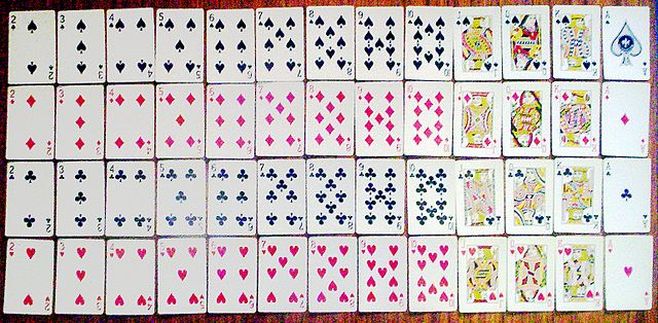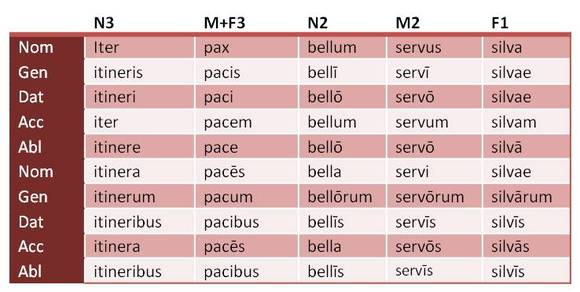|
The board game Clue has been a family favorite for years. I find Clue to be an excellent way to teach prepositional phrases. To refresh your memory, here is the board game: Players move their pieces from room to room and attempt to guess who committed the "murder." Each turn, a player must make a statement, such as "Miss Scarlet did it in the study with the candlestick." Then, they receive information from other players that perhaps it wasn't done in the study so the players move to a new room and make a different accusation. The rules are fairly simple and are included with the game. I don't intend to explain them here.
What is useful here is the repetition of ablative prepositional phrases that students must make throughout the game. To play Latin Clue, I simply have all the students make their accusations in Latin. I teach them the names of all the Clue characters, rooms and weapons. We then do several practice worksheets where we practice writing and translating: "Professor Plum killed Mrs. White in the conservatory with the knife." Now during the game, you usually don't say the victim since the victim is always "Mr. Body" but I find that in practice, it's fun to add a different victim. That way students get practice with nominative, accusative and ablative. You may also be noting that "with a knife" isn't technically a prepositional phrase but rather ablative by means of and the "with" would be dropped. While I understand the logic of this, I find that this activity works best to teach students about prepositional phrases. The idea that you drop out the preposition in some cases is unnecessarily confusing. Once students are comfortable with ablative prepositional phrases and can readily identify a work in the ablative case, then I explain that some types of phrases do not use a preposition. However, this occurs long after Clue is put back in the closet. To do this activity, you need to familiarize students with the Latin words for the Clue rooms, weapons and people list. This word list is in the drive. I tend to write the Latin and then have students guess the English meaning. There are many good derivative discussions to be had here about the words. In a few cases, I have taken some creative liberties. For example, I called the revolver, novum telum because I wished to familiarize students with the word telum. I called Miss Peacock, Domina Purpurea because pavo, or peacock is a third declension noun and initially my students only work with first and second declension words. The second step is to have students practice translating and writing Clue accusations in Latin. I have several different worksheets also included in the drive. Some classes have needed more practice than others. The third step is to divide the students into groups of 3-5 players, give each group a Clue board and have them play the game. To facilitate making the accusations in Latin, I have written the Latin counterparts on all the playing cards. It is a good idea however that all students take their Clue word list to play the game so that they can refer to it. In order to do this activity, therefore, you do need one Clue game for each 3-5 players. Clue is fairly inexpensive, between $15-20.00 retail. Make sure you get Classic Clue and not the deluxe version which is twice the price. If you cannot convince whoever is in charge of purchasing to buy 4-5 games for your classroom, you can acquire them through garage sales or simply by asking students to bring in their own game. Some of my students have donated their boards to my class. The Clue boards in my classroom take up an entire shelf in my closet. New students always ask, "Why do you have so many Clue games?" "You'll see," I reply.
9 Comments
To play Latin poker, you need to visualize the deck of cards as a Latin noun chart. In terms of Poker and many other card games, low cards are to the left and high cards are to the right. You can collect cards going down or a sequence of cards to the right. If you think of the noun chart, as a deck of cards, Poker but also many other card games suddenly become possible. Now let's look at the Latin Noun chart, visually applying the same point value to the deck of cards. Each word represents a card. Each column represents a suit. Cards or words to the left are "low" and words to the right are "high." Usually of course, the chart is usually written with F1 on the left side and N3 to the right but as I like F1 to be the high cards, I wrote it this way so that the comparison would be clearer. The other difference between the noun chart and the card chart is that if you collect the nouns moving across you are creating pairs or three of a kind. You could collect iter, pax and bellum and have three nominatives, for example. This would be the equivalent of collecting three two's - one of hearts, clubs and spades
Therefore, you collect playing cards going across, you are creating a sequence. For example you could collect 2, 3 4 of spades. To collect a sequence of Latin nouns, you move vertically down the noun chart. For example, a player could collect, genitive, dative and accusative of pax and have a sequence. In other words, each noun column corresponds to a suit We could call N2 hearts and F1 spades. There is one more column or "suit" in Latin Poker than in a playing deck. But that doesn't matter. It's close enough. In Latin Poker, the cards closest to the top right of the chart are higher and the cards to the bottom left are lower. That makes Silva (nominative) the equivalent of the ace of spaces. To make a deck for Latin Poker, you need to create one playing card for each of the words listed on this noun chart. the playing cards simply needs to have the word written on one side. I use colored 3x5 index cards and cut them in half. In a regular playing deck, you have 52 cards. In a Latin Poker deck, you will have 48. Really, it works just a well. Once you understand how to use the noun chart as a deck of cards, the rest is easy. Just play poker as you usually do. To see how the various poker hand, correspond to Latin poker, check the Hilara Google Drive and download the Latin Poker hands document in the Card and Board games folder. Make a copy for all of your players so they can see what hands they can construct. Two pair and three of a kind are going to be the most popular hands. What Type of Poker to Play? I generally play Texas Hold 'em because it allows for many students to play at once. In this version, players can match cards in their hand or with cards laid out on the table, called "the flop." I don't remember any more of the rules. You can find them online or ask one of your students. I generally put one of my students in charge of the game and let him or her tell us when it's time to bet, pass or fold. In every class, there's always one poker expert. Since most poker experts get aggravated when players do things out of order, bet at the wrong time etc, I find it easier just to put them in charge rather than arguing with them. What about Chips? Betting? I found several jars of glass terrarium stones at the dollar store. I bought three jars and we use those for poker chips. The white stones are worth five of the purple stones. Everyone gets 5 white stones and one purple stone to start. I place a "two stone" limit on betting, otherwise the temptation is to go "all in" at every opportunity is just too great. When a student runs out of stones, I just give him or her more. That way everyone stays in the game. The winner is the student that has the greatest number of stones at the end. Who can play this game? This game really works best with the more advanced students. Students need to have a very good grasp of the noun chart and be able to identify case of words on sight. If they can't, it just takes too long for them to find them on the chart and the game drags down to a crawl. I have had a blast playing this with Latin III classes and above. It is an excellent activity after a large test or on a day where you have a smaller group.  About 15 years ago, I invented a card game to teach students the personal endings of verbs (o,s, t, mus, tis, nt as well as the infinitive -re). The game is based upon the premise of the popular card game, BS. It worked incredibly well and I still play it with my class. It can be used with a variety of verb tenses but I primarily use it to teach the present tense. The great thing about this card games is that once you explain the rules, and organize the students into small groups (generally between 3-5 players per group), there's not much for you, the teacher to do. It's a very student-centered activity and by the end of it, everyone will be able to conjugate verbs. I can't explain how to make your own Mendax deck because I sold the game to Bolchazy-Carducci. You can buy it here: http://www.bolchazy.com/Search.aspx?k=mendax Note: This is the only activity on my website that is for sale. Instructions on how to make the cards for the other two games, Unus and Latin Poker are on other blogs on this page. (See categories along the side). |
- Salvete Omnes!
- About Me
-
The Stuff is Here
- Beginning Activities
- Card and Board Games
- Kinetic Activities: Get 'em out of their seats
- Mad-libs for All Levels
- Miscellaneous Low or No prep Activities
- Movie Talks!
- Stories Not in Your Textbook
- Stuff for Advanced Students
- Teaching Case
- This I Believe
- White board Activities: Winning.
- Writing in Latin with Students
- Mythology RPG
- Songs
- Quid Novi?
- Links!
- TRES FABULAE HORRIFICAE
- LEO MOLOSSUS
- OVIDIUS MUS



 RSS Feed
RSS Feed
